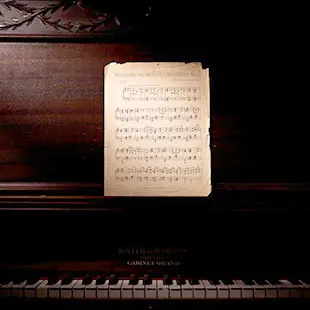Edvard Grieg: The 8 Best Piano Pieces to Learn
The great Norwegian composer wrote some of the most vivid music ever made for piano. We round-up our favorites for players of all levels.
Last updated on 14 Dec. 2024
Edvard Grieg's evocative compositions evoke the wintery spirit of the Nordic countryside. Inspired by the landscapes and traditions of his native Norway, Grieg's works are lyrical and highly expressive. Many of his most celebrated pieces were written to accompany literary or theatrical works, earning him a reputation as one of the Romantic era's most gifted musical storytellers.
Though he composed in numerous genres, Grieg's piano music is known for its accessibility, imagistic style and emotional depth. As a result, it inspires pianists of all skill levels. Grieg's music gives you the opportunity to develop expressive phrasing and technical nuance while transporting you to the wintry landscapes of Scandinavia.
Read on to find a piece to start learning today.
1. Morning Mood
A world-famous melody
"Morning Mood" is centred around an instantly recognizable tune for flute and oboe that conjures images of crisp mornings and gentle birdsong. Originally composed in 1875 as incidental music for Henrik Ibsen's play Peer Gynt, "Morning Mood" has arguably become more famous than the theatrical work it was penned to accompany.
Though not originally composed for piano, "Morning Mood" works beautifully as a solo piano piece, and flowkey has arrangements at three difficulty levels. Those practicing the beginner version should focus on maintaining a smooth legato touch in the right hand to enhance the piece's serene mood. Those tackling the advanced version should ensure they practice slowly at first, gradually building up enough speed to confidently execute the 32nd notes that emulate the mordents featured in the flute melody.
2. In the Hall of the Mountain King
A tense buildup and climax
Another widely beloved standout from the play Peer Gynt, "In the Hall of the Mountain King" is suffused with mischief and mystery that you'll likely recognize from its use in numerous Hollywood films (The Social Network, Rat Race) and television shows (The Simpsons, Doctor Who). Building from a tense opening to a grand climax, it's a thrilling work that demands a confident performance.
A gradual increase in tempo and intensity (also known as a crescendo accelerando) is a hallmark of this piece, and should present even experienced players with a challenge. If you choose to perform it this way, ensure that every note remains distinct as the tempo builds, and don't allow yourself to sacrifice accuracy for speed and gusto.
3. Album Leaf No. 7
A short, graceful piece
"Album Leaf" is taken from Grieg's Lyric Pieces, a collection of 66 short pieces for solo piano that features some of his most well-regarded compositions. "Album Leaf" is a graceful miniature beloved for its songlike phrasing. Ensuring that the right-hand melody sings with clarity and finesse while executing the demanding left-hand accompaniment is no mean feat.
Practicing each hand separately will help you achieve this. In "Album Leaf", the left hand leaps around the keyboard, sometimes by multiple octaves. Without enough practice, these parts can sound jerky and rushed. Before you bring both hands together, listen closely to the left-hand part to make sure you've got it absolutely mastered.
4. Melody No. 3
Haunting and wistful
This haunting and wistful piece is another highlight from Lyric Pieces that demonstrates Grieg's knack for evoking stirring emotions through his music. Much like "Album Leaf", the main challenge here is the left hand, which is tasked with executing flowing arpeggios that span several octaves.
The same advice applies here, too, and practicing each hand separately will serve you well. There are several moments in the piece that require you to pay close attention to dynamics. These crescendos and diminuendos help to enhance the piece's emotive quality, but we'd suggest that you don't focus too closely on dynamics until you have all the notes in the right place.
5. Arietta No. 1
Deceptively simple beauty
"Arietta No. 1" is the opening piece in Lyric Pieces, and a deceptively simple composition that, though it doesn't present much of a technical challenge, requires sensitivity and grace to capture its subtle beauty.
The top notes in "Arietta" should sing out above the rest, and you should focus on developing a smooth and even tone in the accompaniment while the melody soars above. The piece's straightforward rhythms will give you an opportunity to concentrate on mastering its flowing, gentle phrasing. With a piece this simple, there's nowhere to hide, so put plenty of focus on accuracy.
6. Folk Song No. 5
Inspired by Norwegian folk music
"Folk Song" is, as its name would suggest, heavily inspired by Norwegian folk music. The piece is a superb example of Grieg's talent for fusing traditional Norwegian melodies with rich and characterful Romantic harmony. To our ears, there's a yearning, melancholic quality to this piece, perhaps thanks to its diminished chords.
The piece provides another excellent opportunity to practice left-hand leaps, which you can spot in its first few bars. In the right hand, you'll find a number of double grace notes, which ornament the main melody. Typical of works in a Romantic style, these can be challenging to perform with subtlety and precision when they appear in the middle of a melodic line, such as in bar 19.
7. Waltz No. 2
Subtle and elegant
Another selection from Lyric Pieces, "Waltz No. 2" is lighthearted and exuberant with a lilting rhythm and elegant phrasing. There are many subtleties that reward close attention, such as the accents in the left hand, the acciaccaturas in the right, and the numerous instances of ritardando, a performance direction that denotes a gradual decrease in tempo.
Much of the right hand is performed staccato, which can be tricky to pair with a legato left hand, but will help you improve your hand independence.
8. Norwegian Melody No. 6
Like a gorgeous Scandinavian landscape
Last but not least, we have "Norwegian Melody", a vivid piece that masterfully renders the striking beauty of Grieg's homeland. Like many other pieces, the rhythmic vitality heard in "Norwegian Melody" may well have been inspired by folk dances popular in his native country.
It's that rhythm that makes the piece a difficult one to perform confidently. Its descending right-hand part, adorned with decorative triplets, will only be mastered with careful and attentive practice. A light touch is essential, and close attention should be paid to fingering if the piece is to be played comfortably.
Start learning with the flowkey app
All these Edvard Grieg songs – and more – are available to learn on the flowkey app. You'll also have access to a whole library of beautiful piano arrangements spanning a range of genres, including classical, pop, video game music, and more. Download the flowkey app and start learning today.
Read next
5 Beethoven Piano Pieces to Learn for Players of All Levels
Playing Beethoven on piano can be a full-body experience. We've gathered the five pieces we believe best showcase his brilliance—for pianists of all levels.
Claude Debussy: 10 Essential Piano Pieces
Debussy's dreamy compositions remind us of the moving power of music. Discover a new song to learn with our list of 10 of his best pieces.
Learning Piano When You Already Play Another Instrument
You don't have to start from scratch if you want to learn a new instrument. Here we offer suggestions to craft a fun and motivating piano-learning journey for yourself.
Baroque, Romantic, Contemporary: Famous Piano Composers Across the Eras
Take a trip through piano history, from the Baroque right up to the Contemporary period, and learn more about the composers that defined each era.









